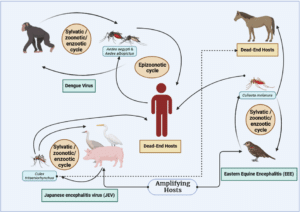Exploring the Intricacies of Encephalitis in Mosquito-Borne Diseases through Vector-Host-Pathogen Interactions: A Critical Review
Mohammad Jamali1*, Syed Mahmood Shahidul Islam2, Jamilur Rahman Bhuiyan3, Calvin R Wei4, Sadia Afrin5, Peter Singh6, Zahra Musarrat7, Prosenjit Rajbongshi8, Timothy Singh9, Rezwan Ahmed Mahedi5,10, Nikolaos Syrmos11, Lemar Cardenas de Guia12
1Assistant Professor, Faculty of Medical and Health Sciences, Liwa College, Al Meryal Campus Al Ain, Abu Dhabi
2Divisional Health and Safety Officer (South Asia and Central Asia); SMEC International Pty Ltd
3Department of Pharmacy, Jahangirnagar University, Bangladesh
4Department of Research and Development, Shing Huei Group, Taipei, Taiwan
5Department of Pharmacy, Comilla University, Cumilla, Bangladesh
6School of Pharmacy, Brac University, Bangladesh
7Department of Pharmaceutical Sciences, North South University, Bangladesh
8Pharmacy Discipline, Khulna University, Bangladesh
9University of Huddersfield, Department of Pharmacy, Queens Gate, Huddersfield, West Yorkshire, England
10Research Secretary, Bangladesh Pharmacists’ Forum (Comilla University), Bangladesh
11Aristotle University of Thessaloniki, Thesaaloniki, Macedonia, Greece
12Curry Elementary School District of Sta Margarita II Division of Samar, Philippines
*Correspondence author: Mohammad Jamali, Assistant Professor, Faculty of Medical and Health Sciences, Liwa College, Al Meryal Campus Al Ain, Abu Dhabi; Email: [email protected]
Published Date: 31-12-2023
Copyright© 2023 by Jamali M, et al. All rights reserved. This is an open access article distributed under the terms of the Creative Commons Attribution License, which permits unrestricted use, distribution, and reproduction in any medium, provided the original author and source are credited.
| Received 05 Dec, 2023 | Accepted 24 Dec, 2023 | Published 31 Dec, 2023 |
Abstract
Environmental changes, medication resistance and sociodemographic shifts have all contributed to a dramatic increase in vector-borne diseases in the last 40 years, impacting both people and domestic animals. Pandemics like the Dengue fever epidemic that hit Bangladesh in 2023 show how devastating these illnesses may be on a global scale. The authors of this work stress the significance of comprehending vector-host-pathogen pathways via their examination of arboviruses in Asia. The ecology and biology of Culex, Culiseta and Aedes species in connection to Dengue Virus, Japanese Encephalitis (JE), Eastern Equine Encephalitis (EEE) and Western Equine Encephalitis (WEE) are explored in a thorough literature review that utilizes MeSH terminology. Beginning with the Japanese Encephalitis Virus (JEV), this article examines the virus’s transmission from insects to vertebrates and, inadvertently, to humans as a disease. We then go on to dengue encephalitis, breaking its intricate pathophysiology into parts. This includes aspects like immune-mediated consequences, systemic problems and direct invasion. The Aedes mosquito is a key player in the human-mosquito-human cycle that transmits Dengue Virus (DENV) and the extrinsic incubation time impacts outbreaks. Continuing to focus on the neuroinvasive effects on horses and people, we have Eastern Equine Encephalopathy (EEE). The interaction between birds and Culiseta melanura mosquitoes highlights the transmission of the enzootic cycle. At last, we look at Western Equine Encephalitis (WEE), which WEEV causes and how it affects both horses and people. Importantly, Culex species, which include mosquitoes and birds, serve as vectors in the enzootic cycle. Factors including climate change and international travel are included in the study’s conclusion, which emphasizes the significance of continuing research to monitor and reduce the worldwide effect of these arboviruses.
Keywords: Dengue Virus; Japanese Encephalitis (JEE); Eastern Equine Encephalitis (EEE); Western Equine Encephalitis (WEE); Viral Transmission
Article Type
Review Article




